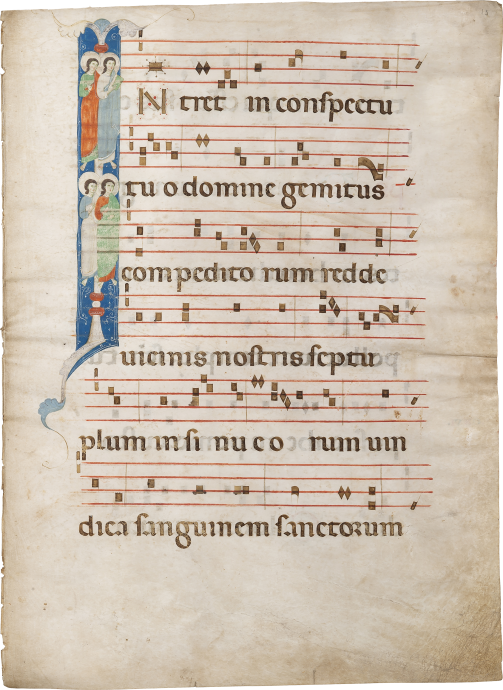Gradual Leaf with Four Martyr Saints in a Historiated Initial I



Bolognese Illuminator
, c. 1290-1295
Bolognese Illuminator
Description
This leaf, depicting four standing martyr saints, comes from a Gradual, where it introduced the Introit to the Mass for Several Holy Martyrs with the text Intret in conspectu tuo domine gemitus. It can be associated with a small coherent group of leaves and cuttings from the same manuscript, one leaf of the Evangelist Matthew (sold, London, Christie’s 1990), and two cuttings, one of the Assumption of the Virgin in a private collection in Milan and another of a holy martyr in the Free Library in Philadelphia (see below). The association of the four fragments is based not only on their common style, liturgy, and music (5-line staves of 30 mm.), but on the shared decorative system of their initials. The initials are characterized by elegant white filigree and, in the case of the examples in Milan and Philadelphia, with white leaves growing into deep blue space within and outside the initials.
The anonymous Bolognese artist responsible for these fragments clearly belongs to the same generation of Bolognese illuminators as the Master of Santa Maria Maddalena di Valdipietra, named after a series of single leaves and a couple of choir books illuminated for the Dominican nuns in Santa Maria Maddalena di Valdipietra in Bologna. The latter, much influenced by Byzantine expressive modes, shapes his mask-like faces within strong contrasts of dark and light (e.g. the dark eye-sockets). Our painter, however, articulates his otherwise planar faces in more graphic manner by highlighting the brightest parts with subtle white brush strokes. In comparison with the lively narratives of his contemporary, the First Master of Sant’Agnese, the narrative style of our painter appears more restrained. His somewhat squat figures interact calmly without dramatic gestures. The same characteristics are found in an illuminator who decorated the initial A in the statutes of the Bolognese “falegnami” of 1298. This artist shares a common stylist idiom – facial structure, graphic execution, squat figures – with the painter of our Four Martyrs, as well as a shared color scheme. Both artists show a predilection for a deep blue ground extending into the inner space of the initial, which is animated by the lively tendrils of elegant and finely drawn white foliage.
For the moment, we cannot be certain that both works are by the same hand. However, they can both clearly be situated in the evolution of Bolognese manuscript illumination between the more conservative “Primo Stile Bolognese” and the “Secondo Stile Bolognese,” the latter evincing more marked Byzantine influence and evident in the more sophisticated illuminators such as the Gerona Master and Jacopino da Reggio. The date of the Bolognese Statues of the Falegnami of 1298 is a welcome approximate indication as a terminus ante quem for the origin of these four fragments, whose style demonstrates how late Duecento illumination in Italy assimilated crosscurrents from Umbria, Florence, Southern Tuscany, and Bologna.
Sister Leaves
a) London, Christies, 20 June 1990, lot 10, Saint Matthew in an Initial E( “Ego autem sicut oliva fructivera,” Introit of the Vigil of the Feast of Saint Matthew, on a leaf from a Gradual containing the Common and Proper of the Saints, 498 x 359 mm.; b) Philadelphia Free Library, Lewis EM 27:01, A Marty Saint in an Initial L (“Letabitur Justus in Domino,” Introit for the Mass of a Holy Martyr, on a cutting from a Gradual containing the Common and Proper of Saints, 213 x 142 mm.; c) Milan, Private collection, Assumption of the Virgin in an Initial G, “Gaudeamus omnes in Domini … (on the back) [ange]li et collaudant (Filium dei Ps.) Eructavit [cor meum ver] bum bonum dico],” Introit to the Mass of the Assumption of the Virgin.
Literature
Silvia Battistini, in Massimo Medica, ed., Duecento. Forme e colori del medioevo a Bologna, Bologna, 2000, pp. 371-373; and Gaudenz Freuler, Italian Miniatures from the Twelfth to the Sixteenth Centuries, Milan, 2013, vol. 1, pp. 184-187.